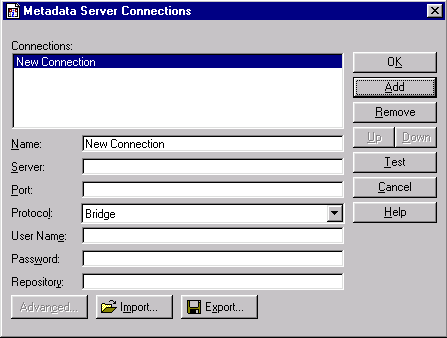|
|
IOM Bridge
Creating a Metadata Configuration File in SAS
The Metadata Server Connections window in SAS enables you to:
Preparing to Use METACON (z/OS Only)
Before you can use the METACON command on z/OS, you must complete these steps:
- Allocate a file using the ALLOC z/OS host command. For example,
ALLOC F(METACFG) SPACE(10 10) TRACKS REUSE
where METACFG is name of the file.
- Use the -METAPROFILE option at SAS invocation to specify the file that you created with the ALLOC host command. For details about the -METAPROFILE system option, see
METAPROFILE= System Option in the SAS Language Reference: Dictionary.
Using the METACON Command (All Hosts)
To create a metadata configuration file in SAS:
Start SAS and enter the METACON command. The Metadata Server Connections window appears.

Click Add to create a new connection and complete the following fields:
- Name
- specifies a name for the server connection.
- Server
- specifies the fully qualified name of the machine on which the server runs.
- Port
- specifies the port that the server connection uses.
- Protocol
- specifies whether the connection uses IOM Bridge protocol or COM protocol.
Note: If you are creating a configuration file for the object spawner, then you must specify Bridge.
- User Name
- specifies the user ID that is used to log on to the server. You might need to specify your authentication domain using the format
domain\user-ID.
- Password
- specifies the password that is used to log on to the server.
- Repository
- specifies which metadata repository on the server to use.
To export the connection information as a metadata configuration file, click Export.
|
